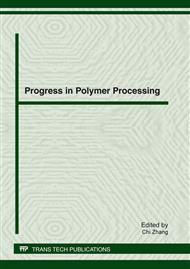[1]
D. Exerowa, P. M. Kruglyakov, Foam and Foam Films: Theory, Experiments, Application, Elsevier, 1998.
Google Scholar
[2]
W. R. Rossen, Foams in enhanced oil recovery, in: R. K. Prud'homme, S. Khan (Eds), Foams: Theory, Measurements and Applications, Marcel Dekker, 1996, pp.413-464.
DOI: 10.1201/9780203755709-11
Google Scholar
[3]
L. W. Holm, The Mechanism of Gas and Liquid Flow through Porous Media in the Presence of Foam, SPE Journal, 8 (1968) 359-369.
DOI: 10.2118/1848-pa
Google Scholar
[4]
J. Ali, R. W. Burley, C. W. Nutt, Foam Enhanced Oil-Recovery from Sand Packs, Chemical Engineering Research and Design, 63 (1985) 101-111.
Google Scholar
[5]
W. Lake, Enhanced Oil Recovery, Prentice Hall, 1989.
Google Scholar
[6]
T. W. Patzek, Field Application of Foam for Mobility Improvement and Profile Control, SPE Reservoir Engineering, 11 (1996) 79-86.
DOI: 10.2118/29612-pa
Google Scholar
[7]
S. A. Zhdanov, A. V. Amiyan, L. M. Surguchev, L. M. Castanier, J. E. Hanssen, Application of Foam for Gas and Water Shut-off: Review of Field Experience, SPE 36914 in European Petroleum Conference held in Milan, Italy (1996).
DOI: 10.2118/36914-ms
Google Scholar
[8]
A. T. Turta, A. K. Signhal, Field Foam Applications in Enhanced Oil Recovery Projects: Screening and Design Aspect, SPE 48895 in SPE International Oil and Gas Conference and Exhibition in China (1998).
DOI: 10.2118/48895-ms
Google Scholar
[9]
D. Megías-Alguacil, P. Fischer, E. J.Windhab, Determination of the interfacial tension of low density difference liquid–liquid systems containing surfactants by droplet deformation methods, Chemical Engineering Science, 61 (2006) 1386-1394.
DOI: 10.1016/j.ces.2005.08.037
Google Scholar
[10]
C. Moules, The Role of Interfacial Tension Measurement in the Oil Industry,information on: www.nttworldwide.com/docs/camtel.pdf.
Google Scholar
[11]
J. Drelich, Ch. Fang, C.L. White, Measurement Of Interfacial Tension In Fluid-Fluid Systems, Encyclopedia of Surface and Colloid Science, (2002). pp.3152-3166.
Google Scholar
[12]
R. P. Woodward, Surface Tension Measurements Using the Drop Shape Method, information on: www.firsttenangstroms.com/pdfdocs/STPaper.pdf.
Google Scholar
[13]
H.J. Xiong, W. Li, Y.Y. Zhang, Error Checking of Measuring Surface Tension by Drop Volume Method, J. of WuHan Polytechnic University, 26 (2007) 13-16.
Google Scholar
[14]
R. Gunde, M. Dawes, S. Hartland, Surface Tension of Wastewater Samples Measured by the Drop Volume Method, Environ.sci.Technol, 26 (1992) 1036-1040.
DOI: 10.1021/es00029a025
Google Scholar
[15]
H. Matsuki, S. Kaneshina, Automatic Surface Tension Measurements of Aqueous Surfactant Solutions by the Drop Volume Method, Langmuir, 10 (1994) 4394-4396.
DOI: 10.1021/la00023a077
Google Scholar
[16]
K Zhang, Z.L. Du, R. X. Li, D.C. Wu, Drop Volume Technique Measuring Interfacial Tension Between Two Liquids, Journal of Sichuan University, 36 (2004) 58-61.
Google Scholar
[17]
Y. L. Niu, Experimental Study on Foam Surface Tension Measurement by the Drop Volume Method, Mine Safety, 12 (1996) 13-16.
Google Scholar
[18]
A.W. Adamson, A.P. Gast, Physical Chemistry of Surfaces, sixth ed., John Wiley & Sons, New York, 1997.
Google Scholar
[19]
W.D. Harkins, F.E. Brown, The determination of surface tension (free surface energy), and the weight of falling drops: the surface tension of water and benzene by the capillary height method, J. Am. Chem. Soc. 41 (1919) 499-524.
DOI: 10.1021/ja01461a003
Google Scholar
[20]
R. Miller, A. Hofmann, K.H. Schano, A. Halbig, R. Hartmann, Measurement of surface and interfacial tensions with an automatic drop-volume tensiometer, Parfuem. Kosmet, 73 (1992) 390-397.
DOI: 10.1007/bfb0118608
Google Scholar


